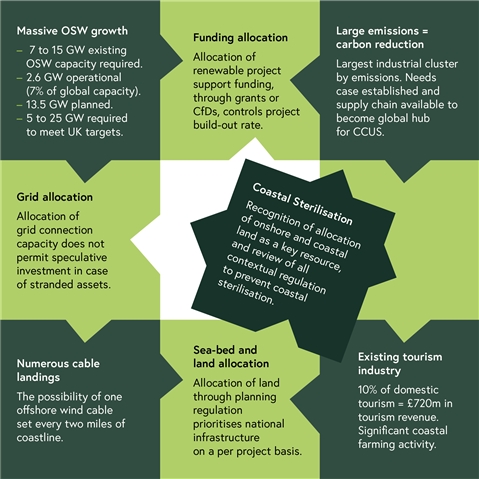The IET Energy Panel has published new report that identifies clean energy network barriers and impacts in the Humber region to achieve net zero by 2050.
Integrated clean energy networks and large-scale renewable energy projects are essential methods to reach the UK Government’s net zero emissions by the 2050 target. The Humber region is the largest industrial cluster in the UK by carbon emissions and therefore must implement large-scale clean energy projects to support these targets.
Our report, The challenges of offshore energy networks in the Humber region, has been prepared for industry, policy and local stakeholders in the Humber region and the wider UK.
Why Humber?
The Humber region was chosen for this case study for several reasons. Geographically, it has the potential to lead the way in striving for net zero as it has a world class offshore wind resource. Also, the underground geology offshore could allow for the capture and storage of CO2.
The Humber region is the largest carbon emissions polluter of any industrial cluster in the UK at over 12.4 MtCO2 per year, equating to 37% of UK wide emissions.2 Upgrading the energy infrastructure to implement more low carbon technologies is critical to reaching the national target of net zero by 2050. For this reason, Humber is taking a leading position on carbon reduction through initiatives such as Zero Carbon Humber, which uses shared hydrogen and CO2 transmission, and integrated offshore carbon capture, utilisation and storage (CCUS).

What are the regulatory barriers to energy integration?
Unfortunately, separative development policies in the UK prevent the co-ordination required to appropriately allocate coastal resources. Under current policy, the regulatory framework allocates the offshore site area, grid connection (for electricity), and a market mechanism is required.
The current legislative systems, as shown in this diagram, covering offshore energy deployment in the UK are driving projects to think individually, pulling apart plans for integration, limiting the potential of clustered offshore wind development and integration with other technologies.
No legislative systems for offshore energy technologies in the Humber region currently enable the development of the whole picture. The developments all fall under NSIP legislation, meaning there are no protections for local stakeholders as they can be overruled.

Conclusions
Clean energy generation and fuel technologies are vital in supporting the UK transition to net zero by 2050. The adoption of large-scale energy infrastructure required to meet the demand of reducing emissions presents many challenges to efficiently coordinate the deployment of innovative and commercial projects.
The Humber region is already home to one of the leading offshore wind industries globally. The region also has the potential to be a global hub for CCUS projects, decarbonising one of the largest industrial clusters in Europe.
While current policies and market-based mechanisms for site allocation, planning, connection and routes to market have previously supported competition and growth in the UK energy sector, they are no longer suited to meet the increased demands of both offshore and onshore stakeholders.
The UK must protect projects that are currently in development to deliver the 2030 target, whilst considering what framework is appropriate for future projects to meet the 2030 to 2050 build-out.
Read our report for characteristics of the Humber region, energy project potential, project development scenarios, barriers to energy integration, lessons learnt, and more: The challenges of offshore energy networks in the Humber region (theiet.org)
Log in to your IET EngX account to leave any thoughts, comments or questions on this topic.